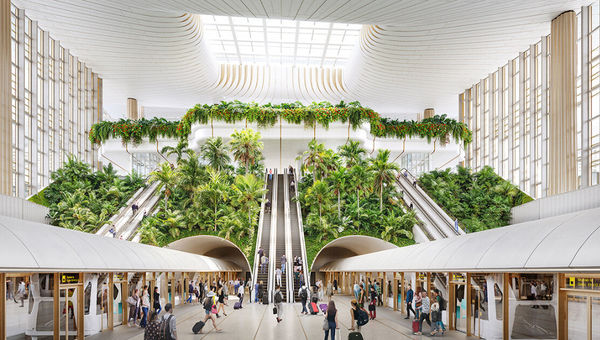The future of airports has been glimpsed with news that Singapore Changi Airport Terminal 5 has begun development, and Dubai’s new Al Maktoum International Airport is pressing ahead with plans to launch passenger operations in 2032.
Both airports will introduce high-tech innovations involving biometrics, artificial intelligence and solar power that will deliver seamless airport journeys for passengers.
Here’s what to expect from these two mega airports as they harness the latest - and future - technologies.
Singapore Changi Terminal 5

Singapore Changi Airport T5 is anticipated to commence operations in the mid-2030s, with an initial annual capacity to handle 50 million passengers. Photo Credit: Changi Airport Group
T5 is designed to be intuitive for wayfinding, with paths that lead passengers either to the boarding gates or the automatic people mover stations, where trains will take them to their gates. Passengers will not need to rely so much on signage to find their way around the terminal.
The design concept is characterised by a collection of overlapping curved roofs with varying heights. The ‘roof leaves’ break the mega terminal building into smaller spaces that are more human scale.
The terminal’s rooftop solar system, can potentially generate enough energy to power up about 20,000 4-room apartments in Singapore for a year.
T5 will see Changi Airport house a ground transportation centre, bringing together train, bus, taxi and other transport services, including ferries. T5 will allow Changi to handle 140 million passengers per year from its current capacity of 90 million passengers.
Al Maktoum International (DWC)

Al Maktoum International Airport, Dubai’s mega cargo and passenger hub, aims to be the world’s largest, supporting logistics, aviation, and future growth beyond Dubai World Central. Photo Credit: COOP HIMMELB(L)AU
A biometric-powered smart corridor will enable immigration clearance in seconds. The smart tunnel can process 10 travellers in the time it currently takes one to pass through conventional immigration smart gates.
Upon arrival, autonomous robots will collect and transfer checked luggage directly from vehicles to the check-in.
A self-bag-drop robot will collect the luggage from passengers when they arrive, while a concierge robot takes care of hand-carry items.
The airport is integrating metro access and electric Vertical Take-Off and Landing (eVTOL) aircraft services for faster transfers.
DWC will replace conveyor belts with biometric-enabled kiosks. Travellers can also opt to have their luggage delivered to their home or hotel using autonomous vehicles.